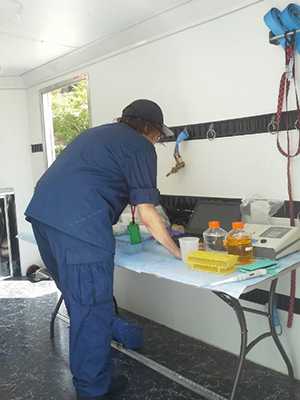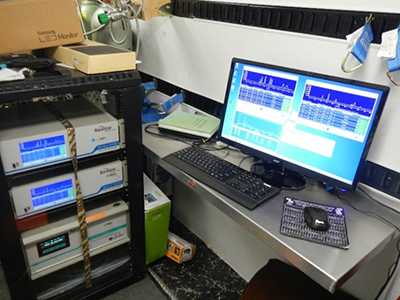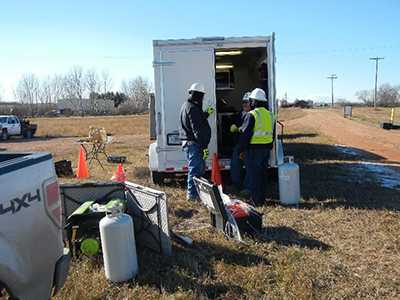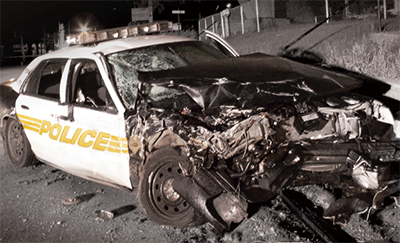NIOSH Research Rounds
NIOSH Research Rounds is a monthly bulletin of selected research at the National Institute for Occupational Safety and Health.
Volume 1, Number 8 (February 2016)
Portable Laboratory Brings Research to the Oil and Gas Field
Researchers at the National Institute for Occupational Safety and Health (NIOSH) often bring the workplace to the laboratory by accurately simulating workplace conditions. In other studies, however, researchers must replicate the laboratory to take it to the workplace.
In one such study, NIOSH researchers are using a new portable field laboratory to determine if workers at oil and gas wells are exposed to potentially toxic materials at harmful levels. These hazards include possible exposure to silica dust in numerous operations, including hydraulic fracturing. This process requires transferring sand and mixing it with water before injecting the mixture deep underground to help extract gas from the rock formation. Other potentially hazardous exposures at the well site include diesel exhaust from numerous engines that power equipment, and hydrocarbon gases and vapors released during manual tank monitoring, sampling, and fluid transfer activities. Although research shows that the highest exposures are among the workers performing the actual extraction, the level of exposure among other workers is unclear. The crucial first step to developing controls to protect all workers is to identify the specific exposure levels associated with different jobs in the oil and gas field so that controls can be designed for the particular task.
The great advantage of the portable field laboratory is that all of the necessary equipment is self-contained in the laboratory, enabling researchers to perform 24-hour air sampling. Previously, continuous sampling was impossible because site visits relied on mail delivery of equipment in cargo boxes, and the necessary equipment for 24-hour sampling was too bulky to ship. With the portable field laboratory, researchers can use high-tech instruments at the well site to identify the exposure levels of volatile gases and vapors. These instruments, called gas chromatographs, analyze the specific chemical composition of the air in real time, eliminating the need to send samples to a laboratory. In addition to its scientific advantages, the portable field laboratory has an added, human advantage: now, researchers can ride to the well site along with their sensitive, expensive monitoring equipment, instead of entrusting it to a third party and simply hoping that it arrives unharmed.
In This Issue
NIOSH Research Rounds is Brought to You By:
- John Howard, M.D., Director
- Fred Blosser, Editor in Chief
- Anne Blank, Story Editor
- Tanya Headley, Contributing Editor
- Ellen Galloway, Copy Editor
- Glenn Doyle, Technical Lead
- Tony Trucco, Technical Support
Get Email Updates
Subscribe to the NIOSH Research Rounds Newsletter:

A researcher reviews data inside the portable field laboratory. Photo from NIOSH.

Three gas chromatographs, left, ready to report to work on-site. Photo from NIOSH.

Researchers working outside the portable field laboratory. Photo from NIOSH.
For more information about oil and gas safety, visit Oil and Gas Extraction.
Survey of Law Enforcement Officers Leads to Road Safety Recommendations

Photo courtesy of the Davenport Police Department.
A concerned motorist in Florida recently made headlines when she gave a law enforcement officer a warning for speeding. Even before this story became news, however, investigators at the National Institute for Occupational Safety and Health (NIOSH) identified recommendations to improve police officers’ road safety after surveying officers in one state.Although motor vehicle crashes are the leading cause of work-related death among officers across the country, few studies have examined how these officers feel about their own safety on the road. To find out, in 2011 investigators surveyed nearly 1,500 officers in the state of Iowa, where NIOSH already had established relationships with several law enforcement agencies. Sixty randomly selected Iowa agencies voluntarily participated in the survey.
Most, but not all, officers surveyed reported wearing a seatbelt, according to the survey findings, published in the peer-reviewed journal Policing: An International Journal of Police Strategies & Management. However, the percentage of officers who reported wearing reflective gear while outside of their patrol car was much lower, at only 4%–10%. Almost all officers reported that they received annual training, but only one third said that it was specific to safe motor vehicle use. Among the officers who did receive motor vehicle training, about one third reported that it was hands-on—for example, pursuit driving, or driving on courses that simulate on-the-job activities. Only half of the officers surveyed believed that their driver training in the police academy prepared them for driving as an officer.
Based on these and other findings, NIOSH made several key recommendations:
-
Wear Your Seat Belt
Seat belts save 13,000 lives every year. Buckle up on every drive, every time. Encourage other officers to do the same.
-
Avoid Distracted Driving
While you cannot eliminate all distractions in your patrol car, consider eliminating cell phone and mobile computer use during lights and siren responses.
-
Wear Your Reflective Gear
Wear a reflective vest or jacket when working around traffic outside of your patrol car. This makes you more visible to motorists. Keep your vest in your gear bag for easy access.
-
Attend Motor Vehicle Training
Update your motor vehicle training regularly. If your agency does not provide training, request funds to attend outside training or look for free training.
-
Know Your Agency’s Policy
Review your agency’s motor vehicle policies. Talk to your leadership about updating these policies to include non-pursuit driving speed restrictions, cell phone and mobile computer restrictions, and seat belt requirements.
For more information, visit:
Law Enforcement Officer Motor Vehicle Safety
Take Charge of Your Safety in and Around Your Patrol Vehicle
Law enforcement officers ‘ risk perceptions toward on-duty motor-vehicle events
Lab Tests Show that Some N95 Respirators Are Fluid-Resistant
In addition to protecting against inhalation of harmful airborne particles, sample units from four models of N95 filtering-facepiece respirators (FFRs) were found to be resistant to fluid penetration by synthetic blood in laboratory tests by the National Institute for Occupational Safety and Health (NIOSH) and an independent testing laboratory. These findings indicate that the NIOSH-approved FFRs likely would meet fluid-resistance requirements that the Food and Drug Administration (FDA) sets for medical masks and surgical N95 respirators. Ultimately, that could increase the supply of respirators for healthcare workers who need protection from occupational exposure to sprays and splashes of blood and other potentially infectious body fluids in public health emergencies like large-scale flu outbreaks.
To mimic workplace conditions, researchers at NIOSH and Nelson Laboratory, in Salt Lake City, UT, used a special type of equipment that sprays synthetic blood at speeds matching those of blood sprayed during a medical procedure. They tested six NIOSH-approved N95 FFR models and five models of medical masks and surgical N95 respirators and found that four of the six NIOSH-approved models of N95 respirators were resistant to the synthetic blood. If larger studies can confirm these findings, the next step is to test whether the devices meet other FDA requirements, such as being fireproof, for medical masks and surgical N95 respirators.
For more information about using N95 FFRs, visit the NIOSH National Personal Protective Technology Laboratory.
To read the journal article, go to Resistance to synthetic blood penetration of NIOSH-approved N95 filtering facepiece respirators and surgical N95 respirators.
Proactive Approach Can Protect Workers with Robotic Coworkers
Early in the science fiction thriller Ex Machina, Nathan Bateman, the brilliant and unnerving CEO of a successful software company, says to his star programmer, “Over the next few days, you’re going to be the human component in a Turing test.” Despite the ominous sound of Bateman’s statement, intensified by his underground laboratory’s location on a remote mountain, the Turing test is relatively simple. Developed in 1950 by artificial-intelligence pioneer Alan Turing, the test measures a machine’s ability to exhibit intelligent behavior similar to that of humans. It involves two people and one machine, with one person observing and evaluating the machine’s interactions with the other person.

Of course, the movie is pure fantasy, but the entry of robots into the modern workplace is real. At the National Institute for Occupational Safety and Health (NIOSH), where protecting workers from workplace hazards is paramount, researchers are taking a proactive approach to prevent injuries among workers who share the workplace with robots. In a recent paper published in the peer reviewed Journal of Occupational and Environmental Hygiene, researchers identified three categories of robots in the workplace—industrial; professional and personal service; and collaborative—and made four recommendations that occupational safety and health professionals can take to protect workers:
- They should be directly involved in developing international standards aimed at ensuring safety of workplaces with human and robot workers.
- They should develop workplace safety standards for maintenance, operation, and interaction with human workers, of professional, personal service, and collaborative (including managerial) robots.
- They should develop proactive approaches for establishing risk profiles of robotic workplaces.
- They should develop and operationalize redundant safety measures to protect human workers who perform maintenance tasks on robot workers.
As with any new technology, protective measures like these are critical to prevent workplace injuries. Although reports of work-related injuries from robots are few, they can happen. Most recently, in June 2015, a third-party contracting employee installing an industrial robot at a Volkswagen assembly line in Baunatal, Germany, died when the robot gripped and pressed him against a metal plate, crushing his chest. What caused the malfunction remains unclear. Earlier, a widely cited 1987 paper reported less serious, but nonetheless worrisome, injuries like pinches and impacts, with 23 among line workers, 6 among maintenance workers, and 3 among computer programmers. Most of these injuries stemmed from preventable human causes like poor workplace design and error.
To read the article, go to Working Safely with Robot Workers: Recommendations for the New Workplace.
To learn more, visit the NIOSH Science Blog: A Robot May Not Injure a Worker: Working Safely with Robots.
- Page last reviewed: February 22, 2016
- Page last updated: February 22, 2016
- Content source:
- National Institute for Occupational Safety and Health (NIOSH) Office of the Director


 ShareCompartir
ShareCompartir